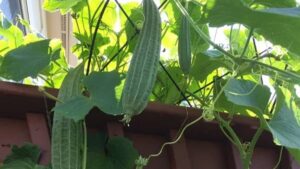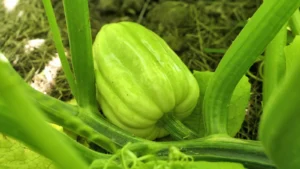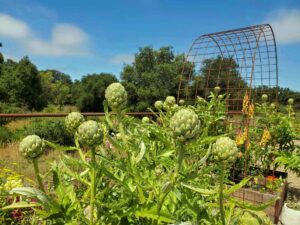How to Grow and Use Daikon Radish: A Complete Guide
Are you looking to add a versatile, nutritious vegetable to your garden? Daikon radish might be exactly what you need. This elongated white radish is a staple in Asian cuisine and offers impressive health benefits while being relatively easy to grow. Whether you have a spacious garden, a modest balcony with container space, or just a sunny windowsill, you can successfully cultivate this crisp, flavorful root vegetable.
In this comprehensive guide, you’ll learn everything you need to know about growing daikon radishes in different settings, harvesting them at the right time, and incorporating them into your cooking. Let’s dive into the world of daikon cultivation!
What Is Daikon Radish?
Daikon radish (Raphanus sativus var. longipinnatus) is a winter radish commonly found in Asian cuisine. The name “daikon” comes from Japanese, meaning “big root.” Unlike the small, round red radishes commonly found in Western salads, daikon radishes are large, carrot-shaped roots that can grow up to 18 inches long and 4 inches in diameter.
These radishes are valued for their crisp texture and mild, slightly sweet flavor that becomes peppery when eaten raw. When cooked, daikon takes on a tender quality and absorbs the flavors of the dishes it’s prepared in.
According to the USDA Agricultural Research Service, daikon radishes aren’t just delicious—they’re also grown as cover crops because their large taproots break up compacted soil, improving its structure and overall health.
Why Grow Daikon?
Before we get into the cultivation details, let’s explore why growing daikon is worth your time and effort:
- Nutritional powerhouse: Daikon is low in calories but high in vitamin C, potassium, and phosphorus.
- Versatility in cooking: It can be eaten raw, pickled, roasted, or added to soups and stews.
- Soil improvement: Even if you don’t harvest all your daikon, the roots break up compacted soil.
- Extended growing season: As a cool-weather crop, daikon can extend your productive gardening season into fall and winter.
- Economic value: With the growing popularity of Asian cuisine in the US market, daikon commands good prices at farmers’ markets and specialty stores.
When to Plant Daikon Radish
Timing is crucial for successful daikon cultivation. These radishes prefer cool weather and will bolt (flower prematurely) in hot conditions, making the roots woody and bitter.
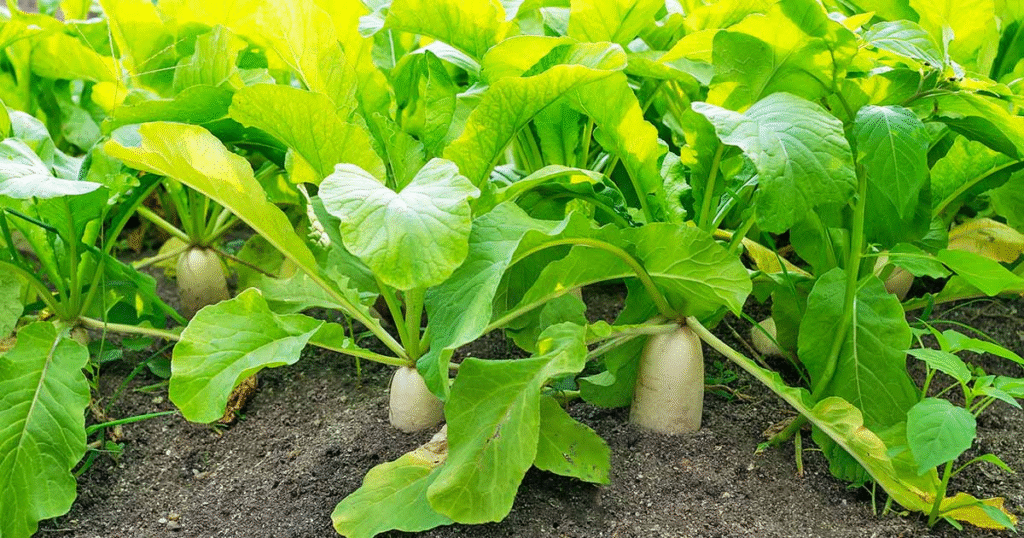
Planting Schedule for Different US Regions
| Region | Spring Planting | Fall Planting | Days to Maturity |
|---|---|---|---|
| Northern US (Zones 3-5) | April to early May | August | 50-70 days |
| Mid-Atlantic (Zones 6-7) | March to April | August to September | 45-60 days |
| Southern US (Zones 8-10) | February to March | September to October | 40-55 days |
| Pacific Northwest (Zones 8-9) | March to April | August to September | 45-60 days |
| Southwest (Zones 9-10) | October to February | Not recommended (too hot) | 40-55 days |
For most regions, fall planting often produces the best results because the radishes mature as temperatures are cooling rather than warming.
How to Grow Daikon in Your Garden
Growing daikon in an outdoor garden gives these large roots the space they need to develop fully. Here’s a step-by-step guide to ensure success:
Soil Preparation
- Choose the right location: Select a spot with full sun to partial shade.
- Test your soil: Daikon prefers slightly acidic to neutral soil (pH 5.8-6.8). You can get a soil test kit from your local extension office.
- Prepare the bed: Dig the soil deeply (at least 12 inches) to accommodate the long roots.
- Amend the soil: Mix in compost or well-rotted manure to improve drainage and add nutrients.
- Avoid fresh manure: According to the National Center for Home Food Preservation, fresh manure can introduce pathogens to root vegetables, so use only composted manure.
Planting Method
- Direct sowing: Daikon doesn’t transplant well, so direct sowing is best.
- Create furrows: Make shallow trenches about ½ inch deep.
- Spacing: Place seeds 2 inches apart in rows that are 12-18 inches apart.
- Cover lightly: Cover with soil and tamp down gently.
- Water thoroughly: Keep the soil consistently moist but not waterlogged.
Ongoing Care
- Thin seedlings: When plants reach 2 inches tall, thin them to stand 4-6 inches apart.
- Watering: Provide consistent moisture (about 1 inch per week), especially during dry periods.
- Mulching: Apply a layer of mulch to maintain soil moisture and suppress weeds.
- Pest management: Watch for flea beetles and cabbage maggots, which can be deterred with row covers.
- Fertilizing: If your soil is poor, apply a balanced, water-soluble fertilizer once a month.
Growing Daikon in Containers
Don’t have a garden? No problem! Daikon can be grown successfully in containers, though you’ll need to choose the right type:
Container Selection
- Depth: Choose containers at least 18 inches deep to accommodate the long roots.
- Width: The container should be at least 12 inches in diameter for a single plant.
- Material: Fabric grow bags work well as they provide good aeration and prevent the roots from circling.
Potting Mix
- Use high-quality potting soil: Garden soil is too heavy for containers.
- Add perlite or vermiculite: This improves drainage and prevents compaction.
- Include compost: Mix in about 30% compost to provide nutrients.
Planting and Care
- Sow seeds: Plant 3-4 seeds per container at ½ inch depth.
- Thin to one plant: Keep only the strongest seedling per container.
- Watering: Container plants dry out faster than garden plants, so check soil moisture daily.
- Fertilizing: Apply diluted liquid fertilizer every two weeks.
- Location: Place your container where it will receive at least 6 hours of sunlight daily.
Indoor Daikon Cultivation
If you’re really short on outdoor space or live in an apartment, you can try growing smaller daikon varieties indoors:
Setting Up Your Indoor Garden
- Choose a variety: Look for shorter daikon varieties like ‘Mini White’ or ‘April Cross’ that don’t need as much depth.
- Select a deep container: Even for smaller varieties, use a container at least 12 inches deep.
- Provide adequate light: Place near a south-facing window or use grow lights for 8-10 hours daily.
- Maintain temperature: Keep the area between 60-70°F (15-21°C) for optimal growth.
Ongoing Care for Indoor Daikon
- Hand pollination: This isn’t necessary for root production but is needed if you want to save seeds.
- Air circulation: Use a small fan to provide gentle air movement, which helps prevent fungal diseases.
- Humidity: Normal indoor humidity levels are fine for daikon.
- Pest vigilance: Check regularly for aphids and spider mites, which are common indoor pests.
Growing Daikon from Seed to Harvest
Whether you’re growing daikon outdoors or indoors, here’s the complete journey from seed to harvest:
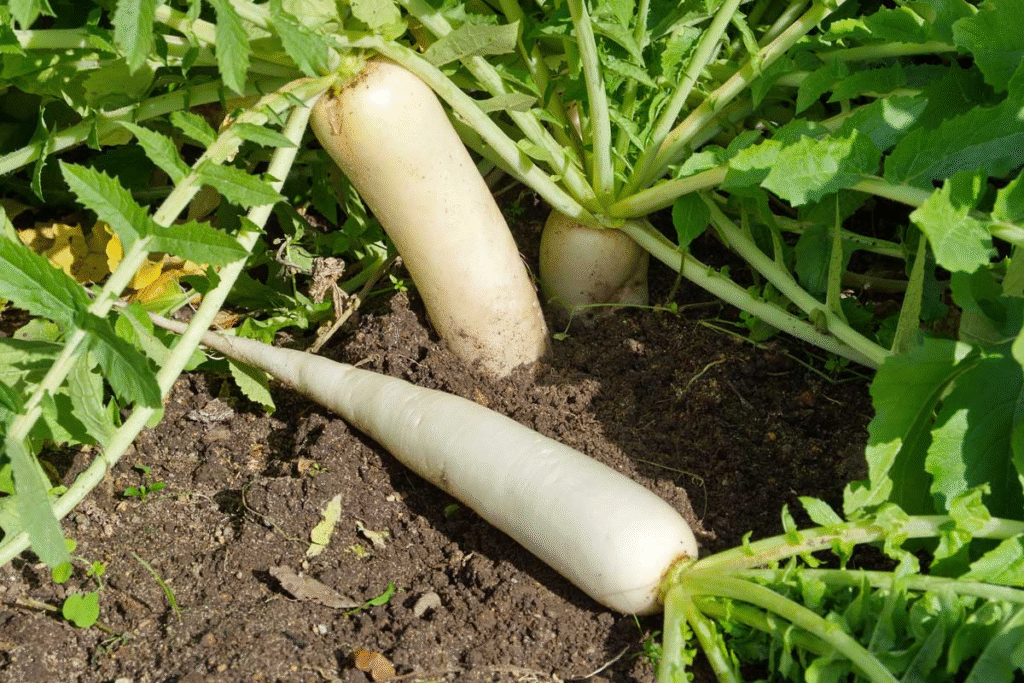
Seed Selection
- Choose fresh seeds: Daikon seeds remain viable for about 4 years if stored properly.
- Variety selection: Common varieties include ‘Miyashige’, ‘April Cross’, and ‘Summer Cross’.
- Seed sources: Purchase from reputable suppliers specializing in Asian vegetables for best results.
Germination Process
- Optimal temperature: Seeds germinate best at 70-75°F (21-24°C).
- Time to germination: Expect to see seedlings in 5-10 days.
- Early care: Keep soil consistently moist during the germination period.
Growth Stages
- Seedling stage: The first true leaves appear after the cotyledons (seed leaves).
- Vegetative growth: Plants develop a rosette of leaves while the root begins to elongate.
- Root development: The edible root continues to enlarge until harvest time.
Harvesting Your Daikon
- Timing: Harvest when roots reach 8-15 inches long, depending on variety.
- Method: Loosen the soil around the plant with a garden fork, then gently pull from the base of the leaves.
- Size indication: The top of the root should be 2-3 inches in diameter when ready to harvest.
Common Problems and Solutions
Even experienced gardeners encounter issues when growing daikon. Here are some common problems and how to address them:
Pests
- Flea beetles: These tiny black insects create small holes in leaves. Control with row covers or insecticidal soap.
- Cabbage maggots: These larvae feed on roots. Prevent with beneficial nematodes and crop rotation.
- Aphids: Control with a strong spray of water or insecticidal soap.
Diseases
- Club root: This fungal disease causes swollen, distorted roots. Practice crop rotation and maintain proper pH.
- Downy mildew: Causes yellow patches on leaves. Improve air circulation and avoid overhead watering.
- White rust: Shows as white pustules on leaves. Remove affected plants and avoid overhead watering.
Environmental Issues
- Bolting: Premature flowering due to heat. Plant during cooler seasons and provide shade if necessary.
- Splitting roots: Caused by inconsistent watering. Maintain even soil moisture.
- Woody texture: Results from harvesting too late or growing during hot weather. Harvest promptly and grow during appropriate seasons.

Storing and Using Your Daikon Harvest
After investing time and effort in growing daikon, maximize your harvest with proper storage and usage:
Storage Methods
- Short-term storage: Remove leaves and store roots in the refrigerator in a perforated plastic bag for up to two weeks.
- Long-term storage: Store in moist sand in a cool root cellar at 32-40°F (0-4°C) for up to three months.
- Freezing: Blanch sliced daikon for two minutes, cool quickly, and freeze in airtight containers.
Culinary Uses
- Raw applications: Grate for salads, slaws, or as a garnish for Asian dishes.
- Cooking methods: Daikon can be steamed, boiled, roasted, or added to soups and stews.
- Pickling: Create quick pickles or traditional Asian pickled daikon.
- Fermentation: Use in kimchi or other fermented preparations.
The Growing Daikon Market in the US
The market for daikon in the United States has expanded significantly in recent years:
- Increased demand: Growing interest in Asian cuisines has boosted daikon consumption.
- Market opportunities: Farmers’ markets, CSAs, and specialty stores all seek locally grown daikon.
- Price points: Fresh daikon typically sells for $2-4 per pound at retail markets.
- Value-added products: Pickled daikon and other preserved forms command premium prices.
Conclusion
Growing daikon radishes can be a rewarding experience for gardeners of all skill levels. These versatile vegetables offer impressive nutritional benefits and culinary possibilities while improving your soil. Whether you’re working with a spacious garden, containers on a patio, or a sunny windowsill indoors, you can successfully grow these delicious roots with the right timing and care.
Remember that daikon prefers cool growing conditions, so plan your planting schedule accordingly for your climate zone. With proper attention to soil preparation, consistent watering, and timely harvesting, you’ll be enjoying home-grown daikon in your kitchen within two to three months of planting.
Why not pick up some daikon seeds today and add this versatile Asian radish to your growing repertoire? Your garden—and your dinner table—will thank you!

